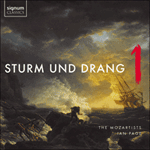
Welcome to Hyperion Records, a British classical label devoted to presenting high-quality recordings of music of all styles and from all periods from the twelfth century to the twenty-first.
Hyperion offers both CDs, and downloads in a number of formats. The site is also available in several languages.
Please use the dropdown buttons to set your preferred options, or use the checkbox to accept the defaults.

| The Mozartists, Ian Page (conductor)» More |
Yet, for all its publicly expressed emotion, this symphony (together with the contemporary No 26, similarly a ‘church sonata’-form Passiontide work) has long been recognized as an example of Haydn’s so-called Sturm und Drang (‘storm and stress’) works. The Sturm und Drang movement in German literature was in effect an early manifestation of the romanticism that would dominate European culture during the following century. Its theatrical works did not, however, reach Eszterháza (where they became very popular) for some ten years after Haydn’s series of minor-key works to which the expression stuck, showing how, despite his seeming cultural isolation, he nevertheless managed in an unconscious way to keep ‘in tune’ with the times.
All four movements of ‘La Passione’ are in F minor, the only relief being the Minuet’s F major trio. Within the movements, too, the tonal range is comparatively restricted: the relative major, A flat, is called upon fairly frequently, but otherwise the keys used are only those most closely related to F, such as C, D flat and E flat. The slow yet inexorable tread of the opening movement suggests a vision of the Via Crucis, while the following ‘Allegro di molto’ really seems to take up the cudgels, with violin leaps over hurtling quavers in the oboes and lower strings and a rhythmic drive forever pushing the music onwards. After the stern Minuet, the ‘Presto’ brings to a close one of Haydn’s darkest and most austere symphonies, a work of such—literal—passion that one cannot help but feel the grief expressed is more personal than collective.
from notes by Matthew Rye © 1991
Et pourtant, malgré toutes ces émotions ouvertement exprimées, cette symphonie (ainsi que le no26 qui lui est contemporaine et aussi composée pour la période de la Passion sous forme de sonate d’église) est depuis longtemps identifiée comme un exemple des œuvres soi-disant Sturm und Drang (littéralement «tempête et passion») de Haydn. Le mouvement Sturm und Drang fut, en fait, une manifestation précoce dans la littérature allemande du romantisme qui allait dominer la culture européenne durant le siècle suivant. Les pièces théâtrales qui le représentaient ne parvinrent à Eszterháza (où elles eurent une grande vogue) que quelques dix ans après la série des œuvres en mode mineur de Haydn qui demeurent qualifiées de ce nom; ce qui démontre que malgré son apparente isolation culturelle, ce compositeur réussit cependant à demeurer, inconsciemment, à l’unisson avec son époque.
Les quatre mouvements de «La Passion» sont tous en fa mineur, le seul dérivatif se trouve dans le trio en fa majeur du Menuet. Dans les mouvements eux-mêmes, l’étendue tonale est comparativement limitée: le relatif majeur, la bémol, revient assez fréquemment, mais à part cela, les seuls tons utilisés sont ceux qui sont les plus proches de fa, tels que do, ré bémol et mi bémol. La lente mais inexorable progression du mouvement initial suggère une vision de la Via Crucis, tandis que l’«Allegro di molto» qui suit semble rellement entrer en lice, avec des échappées de violons au-dessus de croches cascadantes dans les hautbois et les cordes plus basses, et une poussée rythmique qui semble propulser la musique sans cesse en avant. Après le sévère menuet, le Presto mène à sa conclusion l’une des symphonies les plus sombres et austères de Haydn, une œuvre d’une telle passion—littéralement—que l’on ne peut s’empêcher de penser que le trouble exprimé est plus personnel que collectif.
extrait des notes rédigées par Matthew Rye © 1991
Français: Alain Midoux
Bei all ihrer unverbrämten Emotionalität ist diese Sinfonie (zusammen mit der zeitgleich entstandenen Nr. 26, einer ähnlichen Komposition im Stil einer Kirchensonate für die Passionszeit) seit langem als Musterbeispiel für Haydns sogenannte „Sturm-und-Drang“-Werke anerkannt. Der „Sturm und Drang“, eine literarische Bewegung in Deutschland, war sozusagen eine frühe Manifestation der Romantik, die im folgenden Jahrhundert die europäische Kultur dominieren sollte. Die daraus hervorgegangenen Bühnenwerke erreichten Eszterháza (wo sie äußerst populär wurden) jedoch erst an die zehn Jahre nach Haydns Serie von Werken in Moll, mit denen sich der Begriff bis heute verbindet. Daran zeigt sich, daß es ihm trotz seiner augenscheinlichen kulturellen Isolation unbewußt gelang, mit den damaligen Zeitläuften „in Einklang“ zu bleiben.
Alle vier Sätze von „La Passione“ stehen in f-Moll; die einzige Ausnahme bildet das Trio des Menuetts in F-Dur. Auch innerhalb der Sätze ist die tonale Bandbreite relativ beschränkt: Recht häufig wird auf die Paralleltonart As-Dur zurückgegriffen, und auch sonst werden nur Tonarten benutzt, die mit F besonders eng verwandt sind, beispielsweise C-, Des- und Es-Dur. Das langsame, aber unaufhaltsame Fortschreiten des ersten Satzes deutet eine Vision des Kreuzweges an, während das anschließende „Allegro di molto“ erst richtig einsteigt mit Violinsprüngen über eilige Achtel der Oboen und tiefen Streicher und einer rhythmischen Triebkraft, die die Musik stets vorwärtsdrängt. Nach einem strengen Menuett bringt das „Presto“ eine von Haydns düstersten und schmucklosesten Sinfonien zum Abschluß, ein Werk von derart—buchstäblicher—Passion, daß man nicht umhin kann, zu spüren, daß der zum Ausdruck gebrachte Gram eher persönlich als kollektiv ist.
aus dem Begleittext von Matthew Rye © 1991
Deutsch: Anne Steeb/Bernd Müller
 Sturm und Drang, Vol. 1 Sturm und Drang, Vol. 1A turbulent album of music written in the 1760s, when composers dramatically broke free from the superficial charms and gentilities of the mid-eighteenth century rococo.» More |

